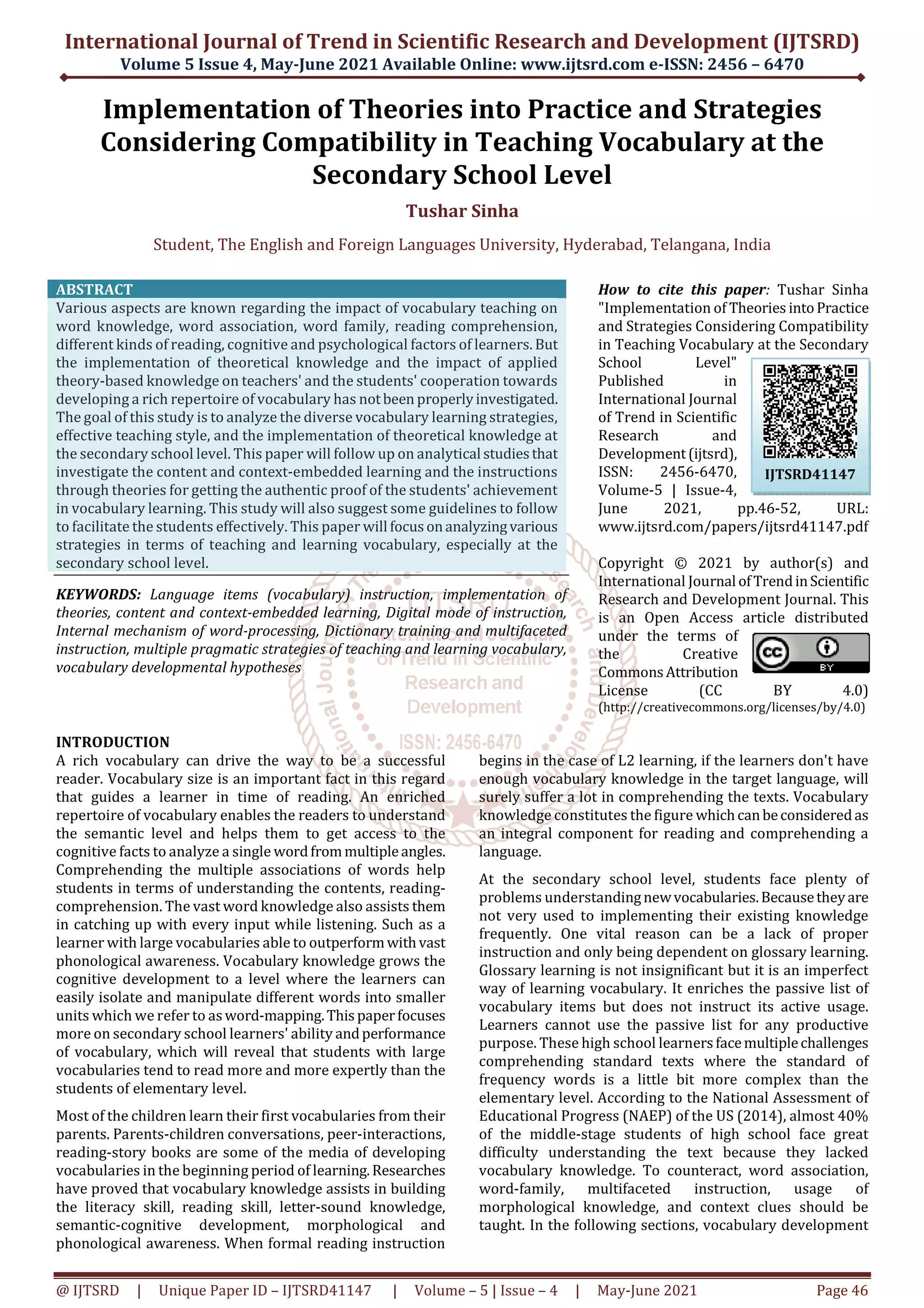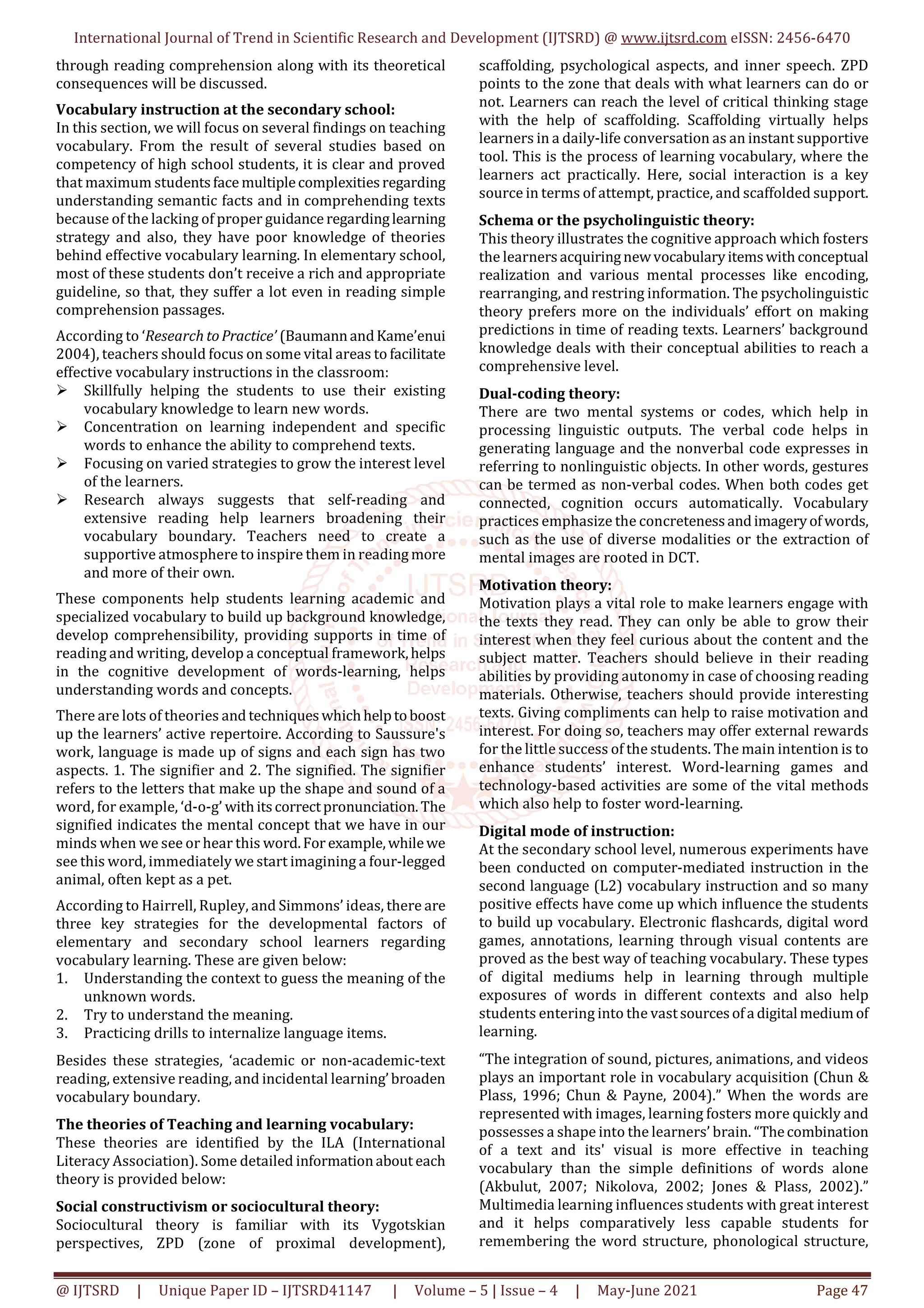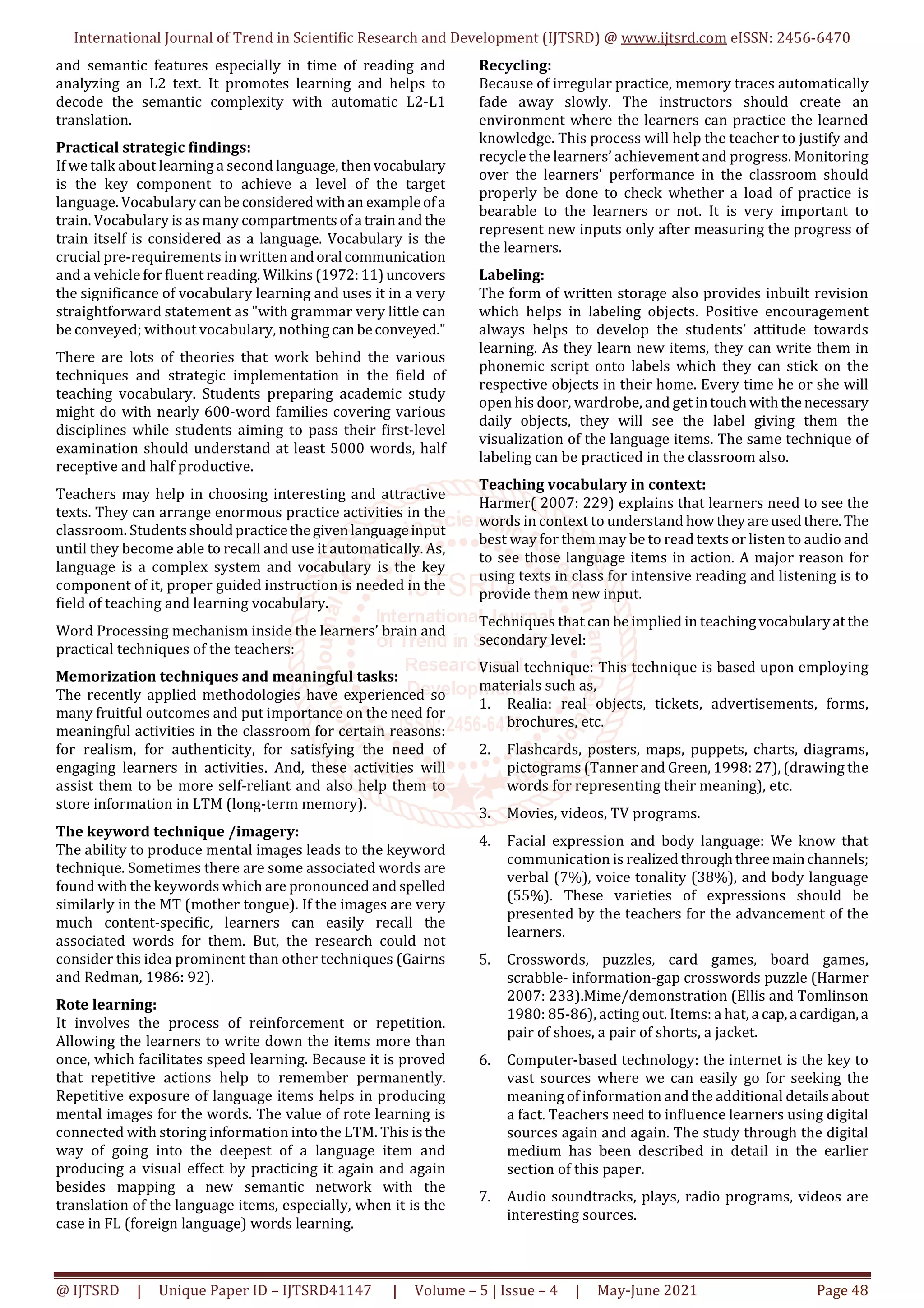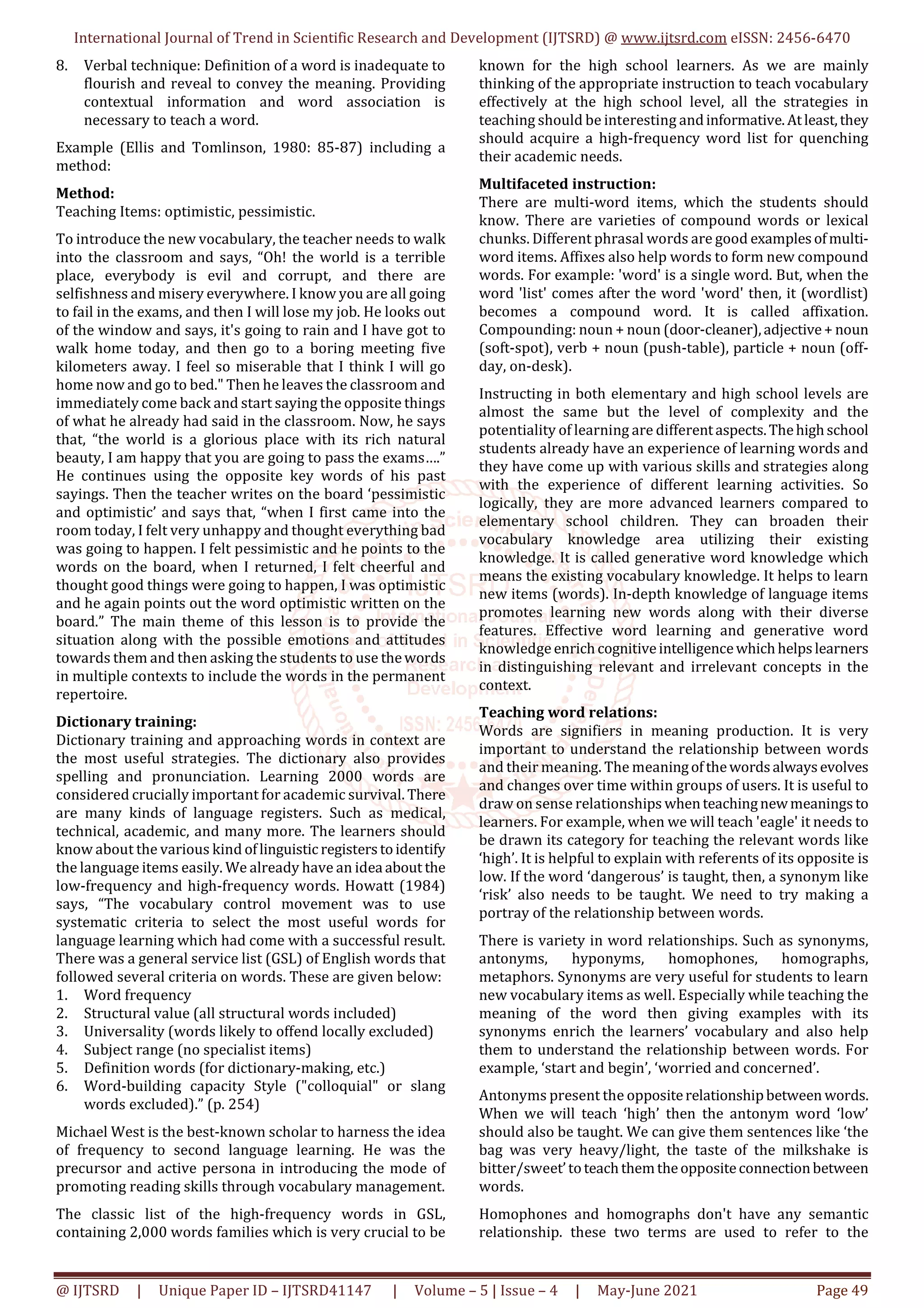This study examines the implementation of vocabulary teaching strategies at the secondary school level, emphasizing the gap between theoretical knowledge and practical application in vocabulary instruction. It highlights the challenges students face in vocabulary comprehension and suggests various methodologies, including digital tools and contextual learning, to enhance vocabulary acquisition. The research aims to provide guidelines for effective vocabulary instruction and address the cognitive and psychological aspects of vocabulary learning.




![International Journal of Trend in Scientific Research and Development (IJTSRD) @ www.ijtsrd.com eISSN: 2456-6470
@ IJTSRD | Unique Paper ID – IJTSRD41147 | Volume – 5 | Issue – 4 | May-June 2021 Page 50
relationship between words which are more a matter of
coincidence. Homophones are words like bare-bear, cellar-
seller, knew-new, hear-hare, know-no, hear-here, bail-bale.
Instructors should introduce the phonetic transcriptions of
these words to the learners for better understanding.
In two recent studies (Baumann,Edwards,Boland,Olejnik,&
Kame'enui, 2003; Baumann, Edwards, Font, Tereshinski,
Kame'enui, & Olejnik, 2002), it is explored thathoweffective
is teaching to middle-grade students by using root words,
prefixes, and suffixes for deriving the word meanings. While
conducting the researches, they also taught students to
scrutinize the text in sentences and paragraphs around
unfamiliar words to infer their meaning.
Metaphor is also a very common aspect in all forms of
language, not just in literature. ‘Buy time, lose time, waste
time, bring to under control’ are some of the most useable
metaphors. Metaphors are used for providing the symbolic
meaning of words. It always gives a strong visual connection
with meaning and also helps to remember the context.
Difficulties faced by students:
Some learners face great difficulties to understand the
metaphors. Because metaphors don’t have one to one
relationship between words. The most useful and instant
application of word relations is the initial presentation of
new vocabulary. It would be difficult to explain words
without reference to their synonyms, antonyms, co-
hyponyms, super-ordinates, and so on. Especially in the
advanced levels, overtly using sense relationships and their
terminology will help in several ways.
Cohesion: Cohesion is an ideal characteristic of any
discourse. It works as a systematic relationship builder
among different parts of a particular context. For example:
Text 1: There is an international stadium in this city.Thelast
international sports competition was arranged at this
stadium. (The connection between the sentences is not
established well).
Text 2: This is the international stadium of this country,
which is one of the most prominentandwell-knowninSouth
Asia, arranged the last international sports competition in
2018. (The connection of ideas is better than the first text).
This is the cohesion of this text.
Coherence: Coherence helps in connecting ideas in our
imagination. It directs the discourse in an organized sequence
by providing supporting information.
Psychological perspectives of the learners:
It is useful to teach different metaphors to help further
understandings, such as a dictionary, an encyclopedia, a
thesaurus, or a computer. We should not assume that the
processes are the same in L1 and L2. Let’s see the process of
the words in mind.
1. Input: how we record words.
2. Storage: how we retain words.
3. Retrieval: how we recall words.
We are babies with very little knowledge of the world when
we learn our first language. Most people learn their second
language when they are older especially, through formal
instruction. The input which the L2 learners receive is very
different than the fact in first language acquisition. Whereas
babies only receive spoken input for learningL1vocabulary,
most L2 learners receive both spoken and written input. In
fact, in many parts of the world, they receive more written
than spoken input. The implication is that the learners are
exposed to rules about both spelling (orthography) and
sounds (phonology) from a very early stage.
For effective teaching, more important information or
features related to a language item should be revealed well
to the learners. The materials going to be followed in
teaching should be considered according to the current
level/ capability of the students.
Vocabulary development through reading-text:
Vocabulary learning and reading academic or non-academic
texts are much more inter-related phenomenon. According
to the identified issues of the national reading panel, it is
necessary to read and analyze thephonemicdetails,phonics,
fluency, vocabulary in time of reading. In a normal sense,
vocabulary is the meaning of the words. But actually, the
combination of these two words (learning vocabulary) not
only stands for just ‘meaning learning’. Vocabulary learning
refers to acquiring words beyond learning the dictionary
definition. There are two forms of vocabulary learning. One
is receptive and another is productive. Receptiveknowledge
can be gained through extensive and intensive reading to
reach a level of high productivity.
The instrumentalist hypothesis:
The main goal of vocabulary instruction is to improve
students’ comprehensibility. Learners with a limited
vocabulary face great difficulties in reading comprehension.
Vocabulary instruction should be made very effective in the
purpose of reading comprehension. This concept oflearning
can be illustrated like: ‘vocabulary learning for reading-
comprehension and, reading-comprehensionforvocabulary
learning. Decades of research indicate that reading
comprehension requires more than knowledgeofindividual
words (Beck & McKeown, 1991; Nagy & Scott, 2000).
Reading comprehension is a wonderful activity in coming to
touch with the new words. If a learner reads a paper on an
interesting concept, he or she will learn new words greater
than the others who are not interested in extensive reading
[note: Extensive readingis'readingtextsforenjoyment]. The
relationship between vocabulary knowledge and reading
comprehension is ‘knowing more words makes someone a
better reader’. It is referred to as a hypothesis. Because,
several studies have been conducted to prove that, ‘teaching
words can improve the comprehensive skill’.
The knowledge hypothesis:
It emphasizes the role of readers’ background knowledge in
comprehending texts. According to the knowledge
hypothesis, there is a causal link from knowledge to
comprehensibility.And,vocabularyknowledgeisconsidered
as the key which contributes to reading comprehension.
The aptitude hypothesis:
If any learners have high verbal IQs, thishypothesissuggests
that it can help them for acquiring large vocabularies.
Teachers can improve their students' vocabulary repertoire
by giving chance to utilize their knowledge about words
already partially known, even if before introducing new
words. Learners can also take individual responsibility
which is termed self-learning, by using such strategies as
keeping a vocabulary notebook. Research has shown that
learning thirty words per hour is possible, at least, in the
sense of gaining some initial partial knowledge. So, the
incremental nature of learning vocabulary is undoubtedly
significant. The implication is ‘except new words, learners](https://image.slidesharecdn.com/11implementationoftheoriesintopracticeandstrategiesconsidering-210713042849/75/Implementation-of-Theories-into-Practice-and-Strategies-Considering-Compatibility-in-Teaching-Vocabulary-at-the-Secondary-School-Level-5-2048.jpg)
![International Journal of Trend in Scientific Research and Development (IJTSRD) @ www.ijtsrd.com eISSN: 2456-6470
@ IJTSRD | Unique Paper ID – IJTSRD41147 | Volume – 5 | Issue – 4 | May-June 2021 Page 51
will be adding to some existing knowledge of the L2 words.
Attempting to enhance this partial knowledge, vocabulary
learning will depend on what learners already know. The
expert Graves (1987) highlights the multiplicity of
vocabulary learning, distinguishing into six types:
1. Learning to read known Words.
2. Learning new meaning senses for known words.
3. Learning new words representing known concepts.
4. Learning new words representing new concepts.
5. Enriching and explaining the meaningsofknown words.
6. Moving words from receptive to productive
vocabularies.
Conclusion:
Vocabulary learning is a vital pre-requirement to develop in
a language. Especially in secondary school, vocabulary
learning is crucially important. Because afterward, the
students need to deal with more complex language items at
the advanced level. The teachers should nurture them well
by giving them diverse strategic knowledge to build up their
skills in learning words. The cognitive and psychological
perspectives and also the barriers of the learners should
have observed to teach effectively. The teachers should
apply these theories practically. Training programs should
be arranged to drive away from the lacking and inevitable
knowledge of the school teachers in terms of teaching
vocabulary. They should be trained up properly. Since
vocabulary is the key component of a language, it is very
necessary to implement the effective and right way of
teaching theories into practice by following these above-
discussed strategies, and techniques in the paper to ensure
enriching the learners’ repertoire with adequate input of
vocabulary items.
References
[1] Anderson, S. (2019). The morphological theory of
René de Saussure’s works.
[2] Akbulut, Y. (2007). Effects of multimedia annotations
on incidental vocabulary learning and reading
comprehension of advanced learners of English as a
foreign language. Instructional Science, 35, 499-517.
[3] Akar. (2010). Teaching vocabulary. M. Kemal Aydin.
[4] Allen, J. (2007). Inside words: Tools for teaching
academic vocabulary, grades 4-12. Stenhouse Pub.
[5] Beck, I. L., & McKeown, M. (1991). Conditions of
Vocabulary Acquisition.
[6] Beck, I. L., McKeown, M. G., & Kucan, L. (2013).
Bringing words to life: Robust vocabulary instruction
(2nd ed.). Guilford Press.
[7] Chun, D. M., & Plass, J. L. (1996). Effects of Multimedia
Annotations on Vocabulary Acquisition. The Modern
Language Journal, 80, 183-198.
[8] Chun, D. M., & Payne, J. (2004). What Makes Students
Click: Working Memory and Look-Up Behavior.
System, 32, 481-503.
[9] English language education section curriculum
development institute. (2009). Enhancing English
Vocabulary Learning and Teaching at Primary Level.
the education bureau.
[10] Ellis, R., & Tomlinson, B. (1980). Teaching secondary
English: A guide to the teaching of English as a second
language.
[11] Fields, R. (2014). TowardstheNational Assessmentof
Educational Progress (NAEP) as an Indicator of
Academic Preparedness for College and Job Training.
Washington, DC: National Assessment Governing
Board
[12] Graves, M. F. (1987). The roles of instruction in
fostering vocabularydevelopment. InM.G.McKeown&
M. E. Curtis (Eds.), thenature ofvocabularyacquisition
(p. 165–184). Lawrence Erlbaum Associates, Inc.
[13] Green, C., & Tanner, R. (1998). Tasks for Teacher
Education: A Reflective Approach.
[14] Harmer, Jeremy. 2007. How toTeachEnglish.Harlow:
Pearson Education Limited.
[15] Howatt, A. (1984). A history of English language
teaching.
[16] Hairrell, A., Vaughn, S., Edmonds, M., Swanson, E.,
Simmons, D., Larsen, R., Rupley, W., & Willson, V.
(2009). The effects of a parsimonious comprehension
and vocabulary intervention on student learning.
[17] Hiebert, E. H., & Kamil, M. L. (2005). Teaching and
learning vocabulary: Bringing research to practice.
Routledge.
[18] Jones, L., & Plass, J. L. (2002). Supporting Listening
ComprehensionandVocabularyAcquisitioninFrench
with Multimedia Annotations. The Modern Language
Journal, 86, 546-561.
[19] Kameenui, E., & Baumann, J. (2004). Vocabulary
Instruction: research to practice.
[20] Kame'enui, E. J., & Baumann, J. F. (2012). Vocabulary
instruction: Research to practice (2nd ed.). Guilford
Press.
[21] Khiyabani, Ghonsooly, & Ghabanchi. (2014). Using
Multimedia in Teaching Vocabulary in High School
Classes. Journal of Advances in English Language
Teaching, 2(1), 1-13. http://http://european-
science.com/jaelt/
[22] McCarthy, M., O'Keeffe, A., & Walsh, S. (2010).
Vocabulary matrix: Understanding, learning, teaching.
Cengage Learning.
[23] Moody, S., Hu, X., Kuo, L., Jouhar, M., Xu, Z., & Lee, S.
(2018). Vocabulary instruction: A critical analysis of
theories, research, and practice. Education Sciences,
8(4), 180. https://doi.org/10.3390/educsci8040180
[24] Nikolova, O. R. (2002). Effects of Students'
Participation in Authoring of Multimedia Materialson
StudentAcquisitionofVocabulary. LanguageLearning
& Technology, 6, 100-122.
[25] Nation, P. (1994). Working with words: Gairns, Ruth
and Redman, Stuart. Cambridge: Cambridge
University Press, 1986. System, 22, 283.
Nagy, W. E., & Scott, J. A. (2000). Vocabulary
processes. In M. L. Kamil, P. B. Mosenthal, P. D.
Pearson, & R. Barr (Eds.), Handbook of reading
research, Vol. 3 (p. 269–284). Lawrence Erlbaum
Associates Publishers.](https://image.slidesharecdn.com/11implementationoftheoriesintopracticeandstrategiesconsidering-210713042849/75/Implementation-of-Theories-into-Practice-and-Strategies-Considering-Compatibility-in-Teaching-Vocabulary-at-the-Secondary-School-Level-6-2048.jpg)
![International Journal of Trend in Scientific Research and Development (IJTSRD) @ www.ijtsrd.com eISSN: 2456-6470
@ IJTSRD | Unique Paper ID – IJTSRD41147 | Volume – 5 | Issue – 4 | May-June 2021 Page 52
[26] Pye, G. (2003). Vocabulary in practice 3.
[27] Sari. (2015). Vocabulary Teaching Strategies Used By
Junior High School EnglishTeachers.semanticscholar.
http://https://www.semanticscholar.org/
[28] Schmitt. (2000). Vocabulary in Language Teaching.
Cambridge university press.
[29] Teixeira, A. B. (2015). The role of Keyboarding in the
development and retention of L2 Spanish vocabulary.
[30] Terfa. (2019). An Assessment of the Practice of
Vocabulary Teaching Strategies in EFL Classes:
Kellem Secondary School Grade 9 and 10 English
Teachers in Focus. Research gate, 7(7), 1-10.
https://www.researchgate.net/
[31] Thornbury. (2004). Principles of Geomorphology
(2nd ed.). CBS publishers and distributors.
[32] Wilkins, D. (1972). Linguistics in language teaching.](https://image.slidesharecdn.com/11implementationoftheoriesintopracticeandstrategiesconsidering-210713042849/75/Implementation-of-Theories-into-Practice-and-Strategies-Considering-Compatibility-in-Teaching-Vocabulary-at-the-Secondary-School-Level-7-2048.jpg)